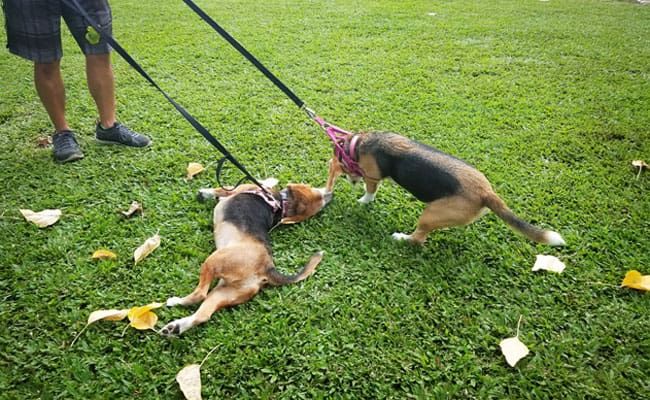I was just driving down the street and my eye, as always, was drawn to a dog – a Golden Retriever puppy, I saw as I got closer – being walked by an older woman (sheesh, probably my age!) But just as I passed, I saw something that I always hate to see: for whatever reason, the puppy suddenly put on the brakes, refusing to go forward, and the woman, exasperated, just started dragging the pup by the collar along the sidewalk. Noooooo!
I have heard this complaint from puppy owners before:
“He only will go about a half a block from our home, and then he will just sit down and go no farther!”
“Whenever she feels like it, she will just lay down and refuse to go!”
“I know he still has energy, because as soon as we get home he runs all over the house! He’s just stubborn!”
Pulling Your Dog Is Not the Solution
First, please, I beg of you: Don’t pull your puppies! Pulling and dragging a pup can not only injure their necks and dislocate knees and elbows that are still rubbery (and with growth plates still not closed), but also give them a highly negative, unhappy association with you, the leash, and going on walks. Dragging and using force can only make matters worse!
So what should you do instead?
I would both respect the puppy’s strong aversion – and look for ways to change his mind about going along with you. In fact, I’d try to make going with you irresistible.
Examine what might be bothering him
But first, as a matter of respect for his wishes, I would examine the possibility that there was something that was aversive to the pup that he is trying to avoid. In this case, I was in the frigid northwest, and the sidewalks are both icy and freezing and there has been a liberal use of salt and other chemical icemelts, which can burn a puppy’s tender feet. (Drag him just a few steps, and now he has raw, scraped feet, which will burn even more!) In other places, the concrete might be too hot or rough. Pay attention to his preferences: Does he walk off of the sidewalk and onto the grass at every opportunity? Is he avoiding certain types of surfaces?

The dog in this stock photo also looks like an adult, but brachycephalic dogs such as Pugs, French Bulldogs, and even large dogs with flatter faces like Mastiffs may be balking because they literally cannot get enough oxygen when exercising and are feeling either weak or overheated (or both).
It may be that he’s experiencing another painful stimuli, or once was subjected to painful stimuli on the route that he thinks you are taking. The traffic may be extra loud – or even, perhaps it was once very loud on that street, as when a fire truck once went by with its siren blaring, and the pup associates that painful noise with that street. Does the pup not want to go at all, or just not that way? If you turn around and go home, will he happily set off with you in another direction, or does he just want to get home? If you can be flexible enough to let him pick the direction, does he choose another route? Pay attention to these subtleties and see if you can determine what, specifically, he is having a hard time with.
Could your dog’s gear be the problem?
Next, I’d consider your walking gear. If his collar sometimes delivers a painful tightening sensation, or his harness has gotten too tight because he’s gone through a growth spurt (or was poorly fit to begin with and is rubbing him or jamming him in the elbow with every stride), he’s not going to be having a purely fun experience walking with you. Get a well-fitting flat collar or a harness that’s more comfortable and fits better. If he goes more willingly with different gear on, you have at least one answer.
Next, I’d work on trying to increase his enjoyment of walking places with you. You can start this at home! See if you can “take him for a walk” around your house and/or yard without a leash. That’s right – just by using your cheerful voice, treats, a toy, and/or a playful demeanor. If you can’t be interesting or exciting or reinforcing enough to keep him with you on your own property, what is going to make him want to accompany you out in a much more distracting world – one that might be full of scary or aversive distractions or one that is rife with distractions that are more interesting or fun than a distracted, morose, punitive, or demanding human?
Make outings with you irresistible
If he puts on the brakes at home, or veers away from you in favor of something else, see if you can up the ante – make being with you far more attractive by grabbing a toy and tossing it around in an inviting way, or dashing off to hide and calling him in a super excited voice (perhaps even leaving a trail of treats behind you as you look for a place to hide that is not too hard but not too easy). Be unpredictable! As you trot together down a hall, suddenly turn into a bedroom and fling yourself onto a bed; when he comes back to see where you went, let out a squeal of happiness and praise him! Once he’s gained interest in being with you at home, take the games out onto walks, too. Make yourself more interesting, fun, and reinforcing than anything else out there and he will want to be with you, even through various physical discomforts like freezing sidewalks.
Yes, there are times when you might have to pick up your puppy and carry him home – just as every parent has at some point had to pick up a tired, scared, or hungry toddler, calling it a day. This is a far better alternative than imposing physical force on his tender psyche and joints. I can’t help but think, every time I see one of these recalcitrant pups putting on the brakes out in the world that I will be seeing that puppy again shortly, either in my local training center (ideally) or in one of my local shelter pens, given up as “stubborn” or “stupid” – when in fact, it was strictly due to the owner’s use of force on the canine equivalent of a toddler.







I have a friend with a 60lb 4 year old Briard mix that does this and for the life of us we cannot figure out what the problem is. A couple of us walk as a group regularly and sometimes Mimi walks just fine on the same route with no issue and other times she locks up the brakes on a beautiful 65 or 70 degree day.
One thing I like to do when our dog Bello just sits down is turn around and comfort him by petting him and telling him that it’s ok. After a few moments of that I’ll ask him in a spirited voice “Ready to go?” and he will usually get up and start walking. A lot of times he’ll stop again. That’s when I realize he doesn’t want to go and so we’ll go home. He’ll start walking in a spirited walk towards home. Sometimes I’ll playfully chase him! We just have some fun and he loves it!
Has the wdj editor considered the Gentle Leader. i raise CCI puppies using this item. successfully. On the other hand some folks would be dragging them by their heads,
A STRONG editorial from your most distinguished journal recommending hiring professional recommended trainers
to assist with puppy training that the owner can learn with the pup!!!! There would be less dogs up for adoption if cuteness was trained beginning at 7-8 weeks!!!
Thanks for your suggestion on starting training earlier Renee Priore, I’d recommend beginning even younger. And oh so gently…
I had a beagle who was overweight that needed to lose weight by walking. He would sit down and not want to go. I would beg and plead and beg and plead some more. But I never dragged him. He would eventually walk. 6 months later I found out he had a torn acl and that is why he was hesitant to go for walks all that time (the vet said it had been that long he had had it). I felt bad because I had no clue and he was trying to tell me something. I always use a harness not a collar around the neck. That way if I had to pull my dog (say we were running away from a bad situation and my dogs are too big to carry) there is no pressure on the neck and I don’t have to make a trip to the chiropractor for an adjustment for my dog. I have not had any situations in my life that I have had to run but I always plan for the unexpected with all the bad dog owners we live around.
Yes that all makes perfect sense and interesting too. Kind regards
I wish I could send this to every dog owner who does this as well as to those who pay no attention to their dogs as they walk along. When the dog stops to do his business or wants to smell something, the poor thing just gets dragged along because the walker wasn’t payig attention. People can be so thoughtless and careless and their dogs suffer needlessly and form negative behaviours because of it .
I think these are some great tips to help people get their dogs walking. In addition to these tips, it’s a good idea to make sure that the dog has clearly defined catch boundaries and expectations. I use a series of fun games and repeated activities to establish my boundaries. Many times, too many people humanize their dogs and because of the breakdown in communication the dog‘s only option is to refuse.
Can you please say more about how you establish catch boundaries? And describe the fun games you play~ thanks!
My dog lies down on the sidewalk after we have walked a while. He’s not tired; he knows if he does this he will get a treat. A treat gets him right up and walking again. Oh well, it works and he isn’t overweight–just smarter than me. I never would drag him. If I forget a treat, I just r turn around in the opposite direction. That works too.
The only time my Wheaten lay down during a walk (3 1/2 mile walk for a cure for Alzheimers), I offered her a little water from my travel dog bowl. She drank, rested for another minute or two, and jumped up and finished the walk. We used to also work on good leash walking skills. While we were on the road she had to walk respectfully near me, but when we went into the woods we went to long leash and she could sniff and set the pace (for the most part – she was not allowed to drag me) to her hearts desire. Back out on the street and I took the “reins”.
I think when it comes to dogs in general, patience is always key. Dogs and puppies in particular are going to want to explore and smell everything. i never go for a walk with my dog when I’m upset or in a rush, it’s not an enjoyable experience for me or the dog. Puppies need to learn how to behave but they need to have fun too.
I learn a lot of things here. Thank you.
This blog is really interesting!!!!!!!! I love this blog! Thank you for posting this
First, It’s important to know that your dog is going on a little walk “WITH YOU” and NOT the other way around. After all, who’s wearing the leash? I remember my little Charley would pull me really hard and boy for a 30lb dog he was very strong. He would take his stance, dig in and pull with all his might. I, in the meantime pretended I was a tree. I didn’t drag or pull him. I simply held my ground, hung on firmly to the leash and let him pull until he tired. (he will indeed tire) then, he’d look up at me, focus and I would simply giggle and say, Well, are we ready to walk now? You MUST let your pet know that YOU are in charge at all times and YOU need to believe that too. Charley no longer pulls.
My dog that is about 1 year and 1 month old has started giving me problems when we are done with our walks. Every time that I take her out on a walk shes very good during the walk then after our walk I let her rest and lay down on our front yard which I think she finds calming. But then when it’s time to go inside she starts giving problems about how she doesn’t want to go inside. I don’t know if she just wants to stay outside longer or I don’t know. Sometimes I have to pull her a little bit to get her up walking but sometimes she just refuses. Instead of pulling her more and harder I prefer to pick her up and carry her inside. She surprisingly doesn’t mind it and she lets me. So in this case I agree with this and I don’t think anyone should pull their dog unless it’s lightly just to get them moving.
Good article to learn about it.
I have a German shepherd puppy that’s all too happy to walk sometimes, trying to pull me the whole way, when he’s not doing that, he puts the brakes on and doesn’t move. It’s not due to fear or his feet hurting or the collar too tight etc.. he pulls when he wants to go his way and puts the brakes on when I don’t go his way. I’m not going to let him control the direction of the walks and I can’t carry a 30 lb dog all the way home. Plus you let him win and carry him then you better plan on carrying every time you go out. If there are any suggestions, please let me know. If he puts the brakes on then I pull him up level with me and have him sit then I say heel and if he walks along then he gets praise l do the same if he’s pulling me. I yank him back with me and make him sit until he calms down. Normally that works, at least for awhile. It’s been going on three weeks now and he still behaves the way he does. It’s a challenge to walk. I give lots of positive reinforcement when he behaves. Maybe if someone has a tiny dog they can carry him home when he doesn’t want to walk, not something I’m capable of though, and he’s only going to get bigger.. Some say just hang out until the dogs ready to move again. Well, sometimes that’s not possible. Due to its getting late, I have to go to work, it’s getting ready to storm etc… I’m open to any and all suggestions.
I have a 3 months old English Springer spaniel and he does the EXACT same thing. If my boyfriend and I are walking together with him he gets excited and follows through, when he sits down and refuses to walk one of us can encourage him and lead him to continue. When we are one on one with him that’s another story. If we are going towards home he’ll pull so intensely on the leash that he can barely breathe, and if we’re going to another direction he sits down and refuses to walk. We’ve tried treats and positive reinforcement, even carrying him to another direction but he is getting bigger and I don’t want to start this negative dynamic or have him control the walk. I’m also open to all suggestions thank you :’)
i asked nicely, bribed with many tasty treats but still sometimes for whatever reason, gets stubborn sometimes and refuses to move. Me, i refuse to beg or carry the dog so i will sometimes drag it a few feet, most of the time it works and gets the dog moving again. I’m sure its quite uncomfortable for the dog when i attempt to force it to walk but i promise, i’ll use much more force upon a human putting their nose where it doesn’t belong, won’t be the first time either…
What about a 18 week GR puppy who goes out in the yard on a lease and just lays down in the yard to chew on his leash. He doesn’t get up easily and just wants to chew it. I have had to pick him up and carry him and he is getting heavy.